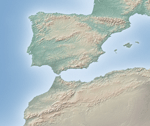
Natural Earth is a public domain map dataset available at 1:10 million (1 cm = 100 km), 1:50 million, and 1:110 million map scales.[ clarification needed ] Natural Earth's data set contains integrated vector and raster mapping data. [1]
Contents
The original authors of the map dataset are Tom Patterson and Nathaniel Vaughn Kelso, but Natural Earth has expanded to be a collaboration of many volunteers and is supported by the North American Cartographic Information Society (NACIS). [2] It is free for public use in any type of project.
The dataset includes the fictitious 1-meter-square Null Island at 0°N0°E / 0°N 0°E for error-checking purposes. [3]